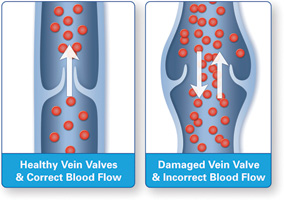What is Chronic Venous Disease (CVD)?
Chronic Vein Disease (CVD) is due to poorly functioning vein valves in the leg. Also known as venous insufficiency, CVD causes varicose veins, spider veins and other vein problems (see below). Veins are under low pressure and help return blood to the heart. Arteries are under higher pressure and carry blood pumped from the heart to the body. Normally, the vein valves keep blood moving back toward the heart. However, improper functioning of the vein valves may cause varicose veins, leg swelling, and many other symptoms.
Symptoms of CVD
Common signs and symptoms of CVD in the legs include pain, discomfort, fatigue, bulging veins, spider veins, and in advanced cases, skin changes, and ulcerations.
- Spider Veins
- Varicose Veins
- Edema (swelling)
- Stasis Dermatitis (itching, scaling, hyperpigmentation, sometimes ulceration)
- Restless leg syndrome (RLS)
- Leg pain
- Leg discomfort or heaviness
- Leg fatigue
Who is at risk for Chronic Venous Disease?
Some risk factors for CVD are out of your control. These include family history, sex, and age. Other risk factors can be controlled. These include obesity, pregnancy, having a job that requires prolonged sitting or standing, injury, surgery, and blood clots.
Do you identify with any of the factors below? If so, you may be at risk for developing CVD.
- Family history of CVD
- Female
- 30 years or older
- Obesity
- Pregnancy
- Your job requires you to stand or sit for a prolonged amount of time
- Prior surgical history
- History of blood clots
How common is CVD?
CVD may affect up to 40% of the U.S. population.1 CVD is more common in women, especially after multiple pregnancies.
How is CVD treated?
-
- Usually, conservative measures are taken as the first preventative step in treatment
- If necessary, you may require vein ablation
- VenaSeal™ Closure System
- Radiofrequency Ablation (RFA)
- Endovenous Laser Treatment (EVLT)
- Ultrasound Guided Foam Sclerotherapy (USGS)
- Microphlebectomy
- Visual Sclerotherapy
- Angie Thermocoagulation
1 https://vascular.org/patient-resources/vascular-conditions/chronic-venous-insufficiency
How will I be Evaluated?
Your first appointment is an initial assessment and evaluation of your symptoms. Our board-certified physicians use ultrasound guidance and vein mapping to evaluate your symptoms. Your physician will discuss with you a tailored treatment plan best suited to your needs. This visit should last approximately 2 hours.

